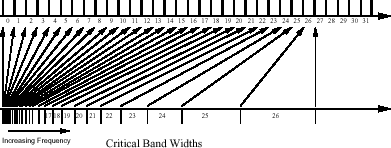Bark: Difference between revisions
| Line 14: | Line 14: | ||
* [http://citeseer.ist.psu.edu/smith99bark.html Bark and ERB Bilinear Transforms, Julius O. Smith (1999)] | * [http://citeseer.ist.psu.edu/smith99bark.html Bark and ERB Bilinear Transforms, Julius O. Smith (1999)] | ||
* [http://ccrma.stanford.edu/~jos/bbt/Bark_Frequency_Scale.html The Bark Frequency Scale, Julius O. Smith (2005)] | * [http://ccrma.stanford.edu/~jos/bbt/Bark_Frequency_Scale.html The Bark Frequency Scale (condensed), Julius O. Smith (2005)] | ||
Revision as of 00:28, 27 November 2005
The bark is the standard unit corresponding to one of the 24 critical bands representing the width of human hearing system. Human hearing critical bands are narrow at low frequencies, but become wider at higher frequencies.
(in Hz) 0, 100, 200, 300, 400, 510, 630, 770, 920, 1080, 1270, 1480, 1720, 2000, 2320, 2700, 3150, 3700, 4400, 5300, 6400, 7700, 9500, 12000, 15500
converting a f to it's bark equivalent:
Bark = 13arctan(0.76f / 1000) + 3.5arctan((f / 7500)^2)

Example: Widths of the critical bands gets wider towards the higher frequencies. MP3 32 equal width subbands (shown on top), based upon PQF filterbank cover the 22.05kHz bandwidth. The width of 1 MP3 subband is about 689Hz (32*689=22.05kHz). Both Bark and ERB bilinear transforms are equivalent in representing the critical bands of human auditory system.
